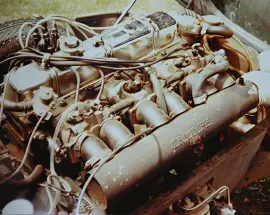1973, Triumph, GT6 MK3

-
Category
-
PostedOct 15, 2025
-
Views103
Year
1973
Brand/Make
Triumph
Model
GT6 MK3
Description
In early 1963 Giovanni Michelotti was commissioned by Standard-Triumph to design a GT version of their recently introduced Spitfire 4 (also designed by Michelotti). An unmodified Spitfire 4 was delivered to Michelotti's design studios in Italy and late in 1963 the prototype Spitfire GT was returned to England for evaluation. The styling of the vehicle was a success but the extra weight of the GT bodyshell resulted in extremely poor performance from the Spitfire's 1,147 cc (70 cu in) Standard SC engine, and plans for producing the Spitfire GT were shelved.
Michelotti's fastback design for the Spitfire GT prototype was adopted by the Triumph racing programme for the 1964 season, as it was deemed to provide an aerodynamic benefit over the standard Spitfire body shape. Fibreglass copies of the Spitfire GT's fastback were grafted on to the race-modified Spitfires destined for competition. The Spitfire racing programme was successful, and in 1965 resulted in 13th overall and a 1st in class at the prestigious 24 Hours of Le Mans (beating their main rivals, the MG Midgets). The Spitfire's competitive success and the continuing commercial success of the production vehicle led Triumph to re-evaluate its shelved plans for a GT version of the Spitfire. To overcome the lack of performance inherent in the heavier body style the Spitfire's 4-cylinder engine was replaced with the more powerful 2.0 L (1,996 cc) Triumph inline 6 originally derived from the SC and then in use in the Triumph Vitesse (which shared a similar chassis with the Spitfire and Triumph Herald). The car was further developed and refined and eventually launched as the Triumph GT6 (dropping the "Spitfire" prefix and adding the 6) to emphasise its GT styling and its 6-cylinder engine.
Michelotti's fastback design for the Spitfire GT prototype was adopted by the Triumph racing programme for the 1964 season, as it was deemed to provide an aerodynamic benefit over the standard Spitfire body shape. Fibreglass copies of the Spitfire GT's fastback were grafted on to the race-modified Spitfires destined for competition. The Spitfire racing programme was successful, and in 1965 resulted in 13th overall and a 1st in class at the prestigious 24 Hours of Le Mans (beating their main rivals, the MG Midgets). The Spitfire's competitive success and the continuing commercial success of the production vehicle led Triumph to re-evaluate its shelved plans for a GT version of the Spitfire. To overcome the lack of performance inherent in the heavier body style the Spitfire's 4-cylinder engine was replaced with the more powerful 2.0 L (1,996 cc) Triumph inline 6 originally derived from the SC and then in use in the Triumph Vitesse (which shared a similar chassis with the Spitfire and Triumph Herald). The car was further developed and refined and eventually launched as the Triumph GT6 (dropping the "Spitfire" prefix and adding the 6) to emphasise its GT styling and its 6-cylinder engine.
Modifications on this car
I removed the original 2-litre six-cylinder engine and traded it for a 2.5-litre engine taken from a TR6. Installing the TR6 engine was very straightforward — it mated directly to the gearbox, requiring only a small elongation of the spigot shaft hole in the end of the crankshaft.
After racing the car at several Triumph Car Club events — including sprints around Bay Park (Mt Maunganui), hill climbs in Clevedon, and gymkhanas — the differential finally gave out. I replaced it with one from a Datsun 240Z, which was much more capable of handling the extra power. This required the manufacture of some axle spacers and a slight shortening of the driveshaft.
Vehicle Still Registered
UNSURE
Maximum Speed
130 mph
Acceleration 0-60mph
8.8 Seconds
1/4 Mile
15.6 Seconds
Engine Cylinders
Inline 6
Engine Capacity
2498 cc
Engine Power
150 HP
Engine Torque
143 lb/ft
Fueling Method
Injection
Fuel
Petrol
Transmission
Manual
Gears
4 Speed
Drivetrain
 Front wheel drive
Front wheel drive Rear wheel drive
Rear wheel drive Four wheel drive
Four wheel drive Limited slip differential
Limited slip differential Overdrive
Overdrive




